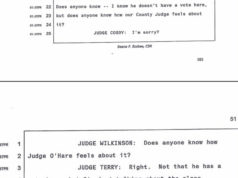Reports of exposure-related deaths are coming in from across the state, and the victims range from children to the elderly. A spokesperson for the Texas Department of State Health Services (DHS) said that a statewide survey of deaths caused by the recent winter storm and subsequent blackout is underway but could take weeks to complete.
Of the customers tracked by PowerOutage.us, nearly 900,000 Tarrant County residents were without power on Tuesday, Feb. 16, as temperatures plunged below zero for the first time in several decades. The promised rolling blackouts largely never materialized, and Fort Worth residents were left completely in the dark or with little to no power outages.
“Typically, our emergency operation plans spread these outages across the service territory on a rotating basis,” said a spokesperson for Oncor, the largest energy provider in Texas. The spokesperson said Oncor was directed by the Electric Reliability Council of Texas (ERCOT), the nonprofit that manages Texas’ network of power generators and transmitters, to “drop a record amount of load,” which prevented regular rotations of blackouts.
Some of our readers weren’t buying it.
“If they can control where the power is being sent, then they could have controlled the length per section,” one commenter said. “This could have prevented the devastating infrastructure losses. People could have maintained some control over any losses. Poor management on the part of Oncor and ERCOT. Most of the managers need to be replaced. Been there too long!”
The catastrophe is not without irony. The complete and utter failure of energy-rich Texas to provide basic services to residents during a crisis has left power companies pointing to the extreme weather conditions as the cause of power supply failures while officials and public leaders demand answers.
Texas relies on several sources of electricity — natural gas (40%), wind (23%), coal (18%), nuclear (11%), and other renewables and nonrenewables (8%) — and every system failed to an alarming degree, largely due to the lack of weatherizing measures that allow wind farms to function in Antarctica and power plants to service communities at extreme latitudes.

Courtesy of Walt Burns
Last week’s problems could be traced back to 1999. That’s when state leaders began deregulating the state power market to provide a competitive and cost-friendly electrical market. Under the current system, power companies are given guidance of best practices, and enforcement practices are nearly nonexistent.
Recent reporting by the Dallas Morning News found that state utility regulators have “issued only three fines related to inadequate weather planning by power generators” since 1999.
The abysmal lack of government oversight hasn’t stopped Gov. Greg Abbott from feigning surprise at the situation that state leaders like him created. The governor recently called for an investigation into the statewide power failure and for the Texas Legislature to consider using state funds to update and weatherize power plants. Abbott’s critics note that for all his bluster, the governor’s campaign war chest is largely funded by the private energy sector — to the tune of $26 million in contributions, according to the Associated Press.
Former District 90 State Rep. Lon Burnam made energy reform a central focus during his 18 years in office. Burnam said that every group tasked with overseeing the state’s electrical grid and power systems — from the governing Public Utility Commission of Texas to ERCOT — is under the sway of private energy groups and lobbyists. The former state representative and Democrat said he held his nose when voting in favor of deregulating the state’s energy sector two decades ago. He said he made the decision because deregulation also benefited the state’s then-nascent solar and wind programs.
Recent false and misleading statements by Abbott and Republican officials that wind turbine failures were the main culprit of last week’s energy meltdown are a distraction from the real reforms that are now needed, Burnam said. “Abbott is giving lip service to weatherizing. People are saying it was an all-time, worst-case scenario. Because of climate change, we will continue to see our climate be in radical flux, whether it is an extraordinary heatwave or a wet spring or drought. They need to pick up my legislation that would require a half dozen agencies to adopt training to anticipate what we would do in these crisis situations.”
Burnam added that locals have a role to play in conserving power, which would have long-term benefits for the environment and the stability of the electrical grid during the next crisis. Texas’ electrical companies and state officials have not made conservation a priority because private interests are more concerned with “quarterly earnings” than helping Texans, he said.
Tarrant County residents are uniquely positioned to influence energy reforms this legislative session, Burnam added. He recommends that anyone who is angry at last week’s energy failure contact State Sen. Kelly Hancock (who represents District 9 and chairs the business and commerce committee) at 817-514-3804 and State Rep. Craig Goldman (who represents District 97 and chairs the energy resources committee) at 817-920-5912 to demand that private companies be held accountable for creating the deadly and dire situation that millions of Texans suffered through last week.
The Weekly welcomes submissions of all political persuasions. Please email Editor Anthony Mariani at anthony@fwweekly.com.












